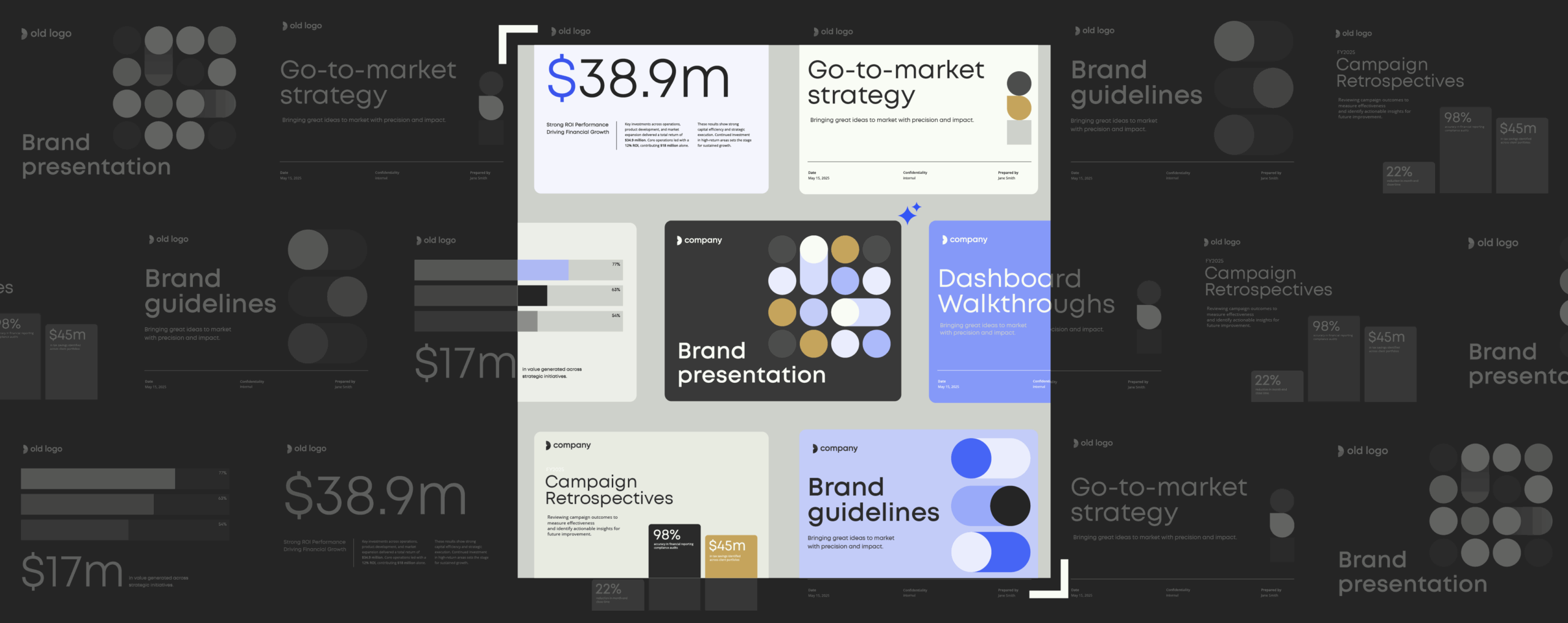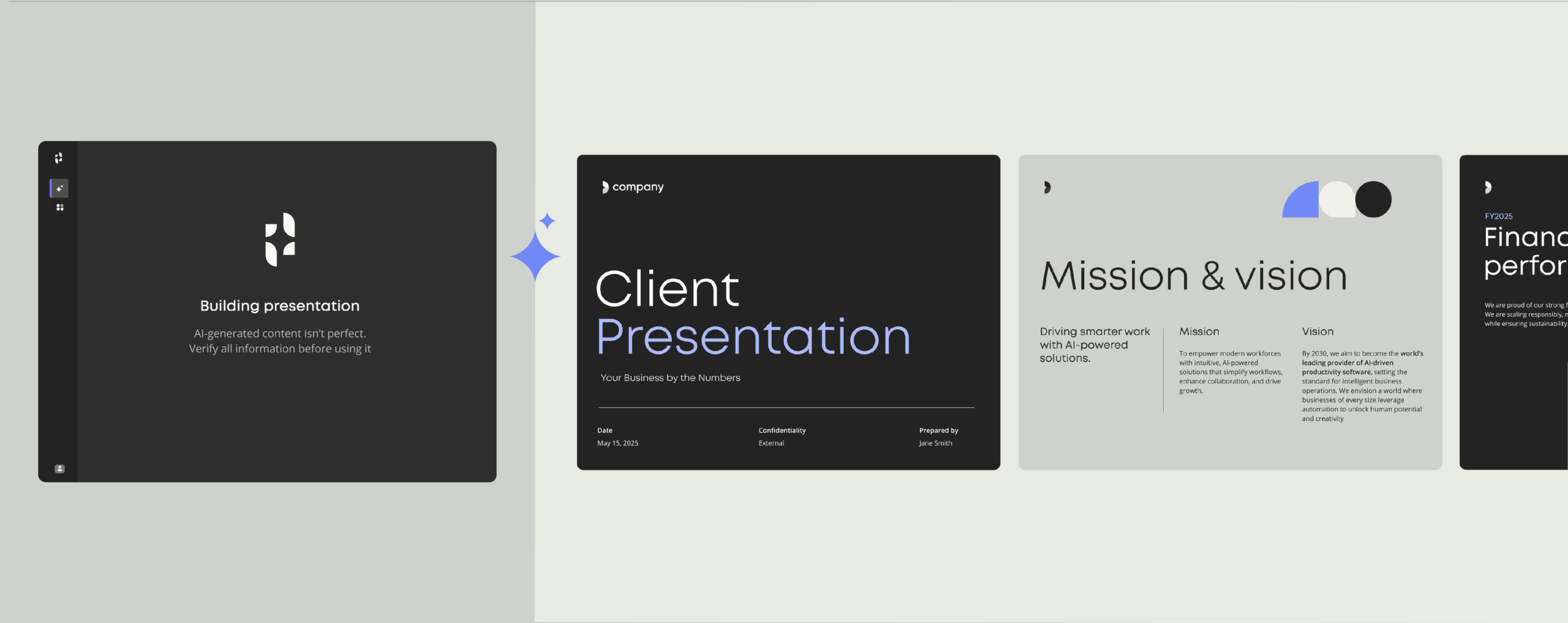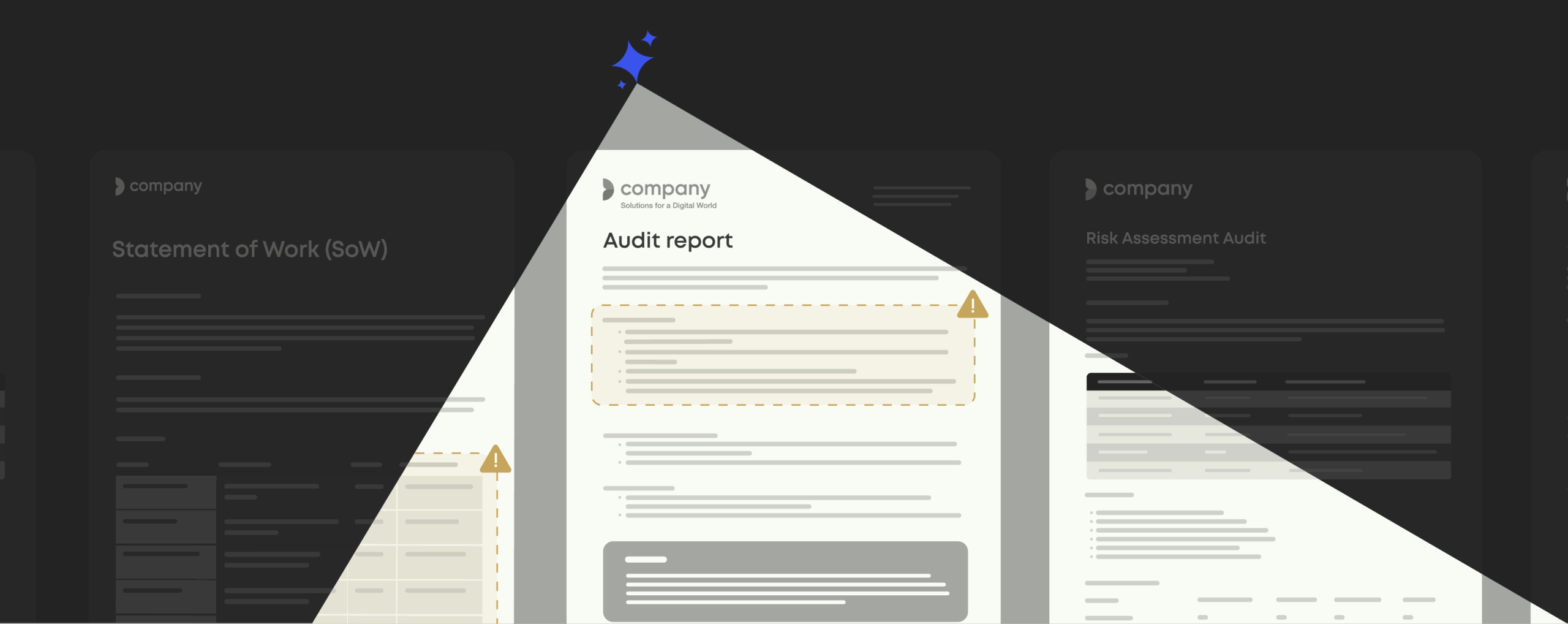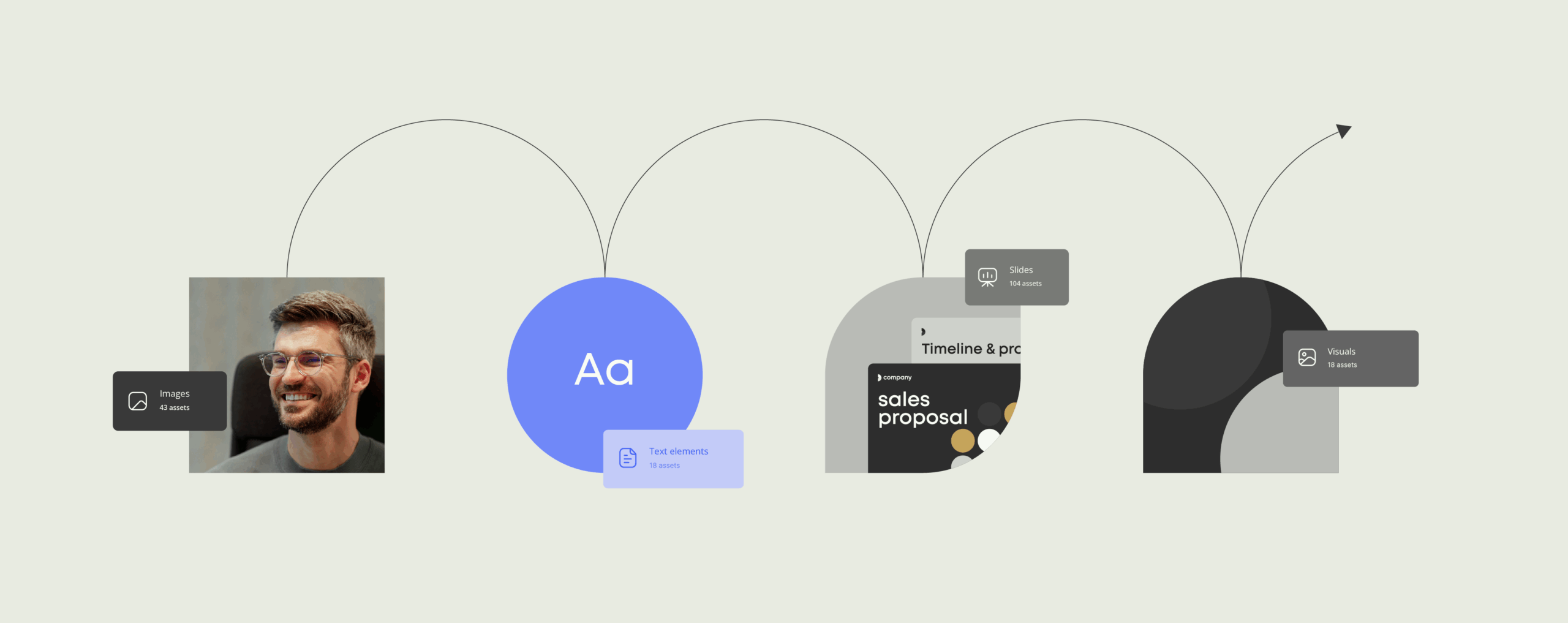Marketing automation strategy: Control brand risk while you scale
How to automate marketing without sacrificing brand control, quality, or compliance
Automation and AI are completely reshaping the way marketing teams work.
Nearly every task in a marketer’s day can now be automated in some way. And with 75% of businesses already using some form of marketing automation, leaders are under pressure to arm their teams with the best tools, before their competitors.
But here’s what most marketing leaders get wrong: they focus on speed without thinking about what happens when you send off-brand, non-compliant, or inconsistent messages at scale. The challenge isn’t just deciding which workflows are worth automating—it’s choosing tools that deliver content that’s on-brand, compliant, and perfectly aligned with your business messaging.
This blog covers everything you need to build a marketing automation strategy that saves time, frees up your team for more strategic and creative work, and protects your brand.
What is marketing automation?
The basics
Marketing automation is software that helps organizations deliver timely, relevant campaigns without the manual work. These platforms act as a centralized dashboard for all marketing campaigns, and they gather and interpret data to send out the right materials at the right time.
Marketing automation tools come in many forms. From marketing orchestration platforms (think HubSpot or Marketo), to document generation platforms, and even AI agents. They all share the same purpose: to cut down on repetitive work, move campaigns to market faster, and deliver consistent, personalized experiences that grow the business.
And the impact is substantial. On average, companies achieve a 544% ROI with marketing automation, and 98% of B2B marketers say marketing automation is critical to success. It’s already the backbone of any modern marketing team, and as AI evolves, its role is only getting bigger.
How it works with your CRM
Marketing automation and CRM platforms both use customer data, but they play different roles. CRMs act as a customer database that stores things like contact details, interaction history, and pipeline status. Marketing automation platforms then use that data to run campaigns, nurture leads, and trigger follow-ups based on behavior.
For enterprise businesses, integration between the two is essential. Without it, campaigns lack the insight needed for accurate targeting and personalization.
Connecting your entire marketing ecosystem
The real impact comes when automation connects not only with your CRM but with the wider stack. That includes your DAM for brand assets, CMS for content, ERP for business data, sales enablement platforms for go-to-market, and document automation for customer-facing materials.
When these systems work together, marketing and sales operate from a single source of truth. Content stays accurate and compliant, campaigns move faster, and customers experience a consistent brand at every touchpoint.
marketing automation
Six types of marketing automation platforms
- Marketing automation and journey orchestration
- Document generation and brand automation
- Email and lifecycle marketing
- Analytics and attribution
- Customer data and personalization (CDPs and decisioning engines)
- Ads and audience management
Work smarter with automation
Discover new ways to save time and reduce errors with document automation. See how teams use smart tools to work faster.
First, let’s get familiar with what’s on the market.
When people talk about “marketing automation,” they often mean journey orchestration platforms like HubSpot, Marketo, or Marketing Cloud Account Engagement (Pardot) that manage campaigns and customer journeys. But that’s only one piece of the puzzle.
Enterprises rely on a mix of automation platforms that each solve a different challenge: orchestrating campaigns, generating compliant content, scaling email, proving ROI, personalizing experiences, and managing ads. Organizations use a combination of tools, depending on their goals.
Here are six of the most common types of platforms and why they matter.
1. Marketing automation and journey orchestration
These platforms give marketing teams one place to plan, track, and run campaigns across every channel. They allow teams to design workflows that automate customer journeys, with triggers that launch responses based on behavior.
For example, if a prospect downloads a whitepaper, the platform automatically logs that action, updates their lead score, and sends a follow-up email. If they attend a webinar, sales gets a notification. If engagement drops, they’re added to a reactivation flow.
What these platforms do:
- Run campaigns across email, ads, social, and websites
- Sync with CRM systems to keep data accurate
- Automate follow-ups based on customer behavior
- Segment audiences for targeted messaging
- Score leads to show sales readiness
- Track which campaigns drive revenue
- Support account-based marketing
Why it matters: They cut down manual work, keep sales and marketing aligned, and ensure customers get timely, relevant interactions at every stage.
Platforms to research: HubSpot, Marketo, Pardot (Marketing Cloud Account Engagement), Oracle Eloqua, Braze, Dotdigital.
2. Document generation and brand automation
They say good marketing is about getting the right content to the right person at the right time. Traditional automation platforms cover the “right time.” But what about the “right content”? How are you keeping deliverables high-quality, on-brand, and compliant? And who’s governing AI to make sure what it produces meets those standards?
For enterprise-scale businesses, document generation and brand automation is critical. Proposals, contracts, and sales materials are revenue-driving documents. When they’re inconsistent, inaccurate, or slow to produce, it stalls deals and erodes trust.
These platforms put guardrails in place so every document is compliant, consistent, and high-quality, no matter who creates it. They connect to systems like CRMs and pricing databases to pull in the latest data, keep templates updated with approved language, and give brand teams control over how GenAI is used.
The result is faster turnaround, higher quality, and content that wins business.
What these platforms do:
- Generate branded proposals and contracts using live CRM and pricing data
- Apply brand rules automatically across sales and marketing materials
- Keep templates accurate with up-to-date legal and product content
- Add governance layers to GenAI outputs for quality and compliance
- Track document usage and engagement across markets
Why it matters: Enterprises create thousands of documents every day. Automating this process saves time, reduces risk, and protects brand integrity, all while giving sales teams polished materials that move deals forward. At scale, that’s a huge competitive advantage.
Platforms to research: Templafy, PandaDoc, DocuSign, Conga, Proposify, GetAccept, Nintex DrawLoop.
3. Email and lifecycle marketing
Email remains one of the most effective marketing channels, and dedicated platforms make it smarter at scale. They handle massive databases, track behavior, and deliver personalized campaigns, like abandoned cart flows, re-engagement sequences, or product recommendations.
The trade-off is that they focus mainly on email and sometimes SMS/push. Most enterprises integrate them with orchestration platforms for full multi-channel coverage.
What these platforms do:
- Segment audiences by purchase history and engagement
- Trigger automated sequences from customer actions
- Optimize send times, subject lines, and content
- Personalize messages by industry, role, or preferences
- Connect with CRM and e-commerce platforms
- Track performance and revenue impact
Why it matters: Email consistently delivers the highest ROI of any channel. These platforms give enterprises the sophistication to run it as a true revenue driver.
Platforms to research: Klaviyo, ActiveCampaign, Mailchimp, Brevo, Omnisend, Constant Contact.
4. Analytics and attribution
Complex buying journeys make it hard to know what’s working. Analytics and attribution platforms track every touchpoint—ads, emails, content, webinars, sales calls—and show how each contributes to pipeline and revenue.
What these platforms do:
- Track customer interactions across channels and regions
- Measure ROI with multi-touch attribution
- Show which campaigns and content drive revenue
- Flag performance issues and recommend fixes
- Predict customer value and churn risk
- Produce reports for leadership
Why it matters: Proving marketing’s impact is essential. These platforms help optimize spend, demonstrate ROI, and defend budgets with confidence.
Platforms to research: Google Analytics 4, Adobe Analytics, Salesforce Analytics Cloud, HubSpot Analytics, Marketo Measure (Bizible), Mixpanel, Amplitude.
5. Customer data and personalization (CDPs and decisioning engines)
Personalization requires more than workflows. Customer Data Platforms (CDPs) unify data from multiple sources into a single customer profile, then feed that into campaigns. Decisioning engines go further, triggering personalized experiences in real time.
What these platforms do:
- Unify data from CRM, web, mobile, and offline channels
- Build accurate customer profiles and audiences
- Power personalization across email, ads, web, and apps
- Handle consent and data governance
- Enable real-time recommendations and journeys
Why it matters: Without a reliable data layer, automation platforms can’t deliver relevant or compliant experiences. CDPs provide the foundation for personalization at enterprise scale.
Platforms to research: Segment, mParticle, Tealium, Salesforce Data Cloud, Adobe Real-Time CDP, Dynamic Yield.
6. Ads and audience management
Advertising platforms increasingly function as automation engines of their own. They allow enterprises to build and sync audiences, automate bidding, and manage spend across search, social, and programmatic channels.
What these platforms do:
- Build and sync audiences across paid media
- Automate bidding and budget allocation
- Integrate with CRM/CDPs for precise targeting
- Measure campaign performance and ROI
- Run experiments to optimize creative and spend
Why it matters: Paid media is often the biggest line item in the marketing budget. Automating campaign management ensures more efficient spend and stronger returns.
Platforms to research: Google Ads, Search Ads 360, Meta Ads, The Trade Desk, Skai.
Why strategy is critical in marketing automation
Automation tools are everywhere, but you can’t invest in all of them. The right marketing automation strategy helps you choose where to invest for ROI, so you get measurable results that defend your budget.
Here’s what happens when you get the strategy right.
Build trust that converts prospects into customers
Professional, consistent materials build credibility throughout the entire sales process.
When automation generates proposals, presentations, and follow-up materials that maintain brand standards and accuracy, prospects see you as organized and reliable. That consistency across every touchpoint creates trust and increases wins.
Companies using marketing automation to nurture prospects see a 451% increase in qualified leads, with nurtured leads making purchases 47% larger than non-nurtured prospects. (Salesforce)
Free up talent to focus on revenue-driving activities
Your best people shouldn’t be stuck in repetitive admin work. Manual tasks like data-entry, formatting documents, and updating templates pull employees away from valuable work. With automation handling the time-draining parts of content creation, your team can focus on strategy, clients, and the creative work that actually grows the business.
Document automation saves employees an average of 30 days per year by streamlining document workflows, according to company research. (Templafy)
Maintain quality standards as you scale
Brand inconsistency kills deals. Every off-brand email attachment or outdated proposal tells prospects you don’t pay attention to details. Automation that maintains brand consistency across thousands of touchpoints shows you’re organized, professional, and reliable—the kind of company worth doing business with.
67% of professionals want to see document creation tasks automated to improve consistency and reduce errors. (Templafy)
Reduce compliance risks and costly errors
Mistakes multiply when you scale. What starts as a small compliance error becomes a major liability when automation sends it to thousands of prospects. The right automation includes governance controls that ensure every touchpoint meets brand, legal, and regulatory requirements, so scaling efficiency doesn’t mean scaling risk.
Organizations implementing document automation see up to 1,239% ROI by reducing errors and streamlining compliance processes, according to Forrester research. (Forrester via Templafy)
Create predictable growth engines
Predictability drives growth. Revenue teams need consistent, repeatable processes they can count on. When automation creates systematic workflows that deliver high-quality results every time, you can confidently forecast pipeline contribution and scale without worrying about quality dropping off. That predictability is what enables aggressive growth targets.
Companies using document automation report creating over 390,000 on-brand documents annually while saving 63,000 hours of manual work. (Templafy)
How to build your automation strategy: Step-by-step guide
Here’s a complete guide to building an effective marketing automation strategy.
Step 1: Map your customer touchpoints and identify automation opportunities
Document how prospects move through your sales process and identify specific friction points where automation could add value. Focus on repetitive tasks, manual handoffs between teams, and places where leads typically drop off. Prioritize workflows that directly impact revenue velocity or customer experience.
Key questions to ask during mapping:
- Where do prospects typically go silent or drop off?
- Which tasks consume the most time from your highest-value team members?
- What manual processes create delays between marketing and sales?
- Which touchpoints require consistent brand presentation but currently vary in quality?
- Where do compliance or legal requirements create bottlenecks?
- Why it matters: They cut down manual work, keep sales and marketing aligned, and ensure customers get timely, relevant interactions at every stage.
- Platforms to research: HubSpot, Marketo, Pardot (Marketing Cloud Account Engagement), Oracle Eloqua, Braze, Dotdigital.
Step 2: Choose platforms based on your biggest business challenge
Rather than defaulting to any single platform type, identify where automation could deliver the most immediate business value:
- Brand consistency problems → Document generation platforms (like Templafy) that ensure every customer-facing material maintains professional standards
- Lead nurturing gaps → Workflow orchestration platforms that automate customer journey management
- Email performance issues → Specialized email platforms with advanced segmentation capabilities
- Attribution blind spots → Analytics platforms that provide comprehensive performance tracking
Select solutions designed to integrate well with others, as the best strategies combine specialized tools rather than relying on all-in-one platforms.
Essential questions to ask vendors:
- How does your platform integrate with our existing CRM and marketing tools?
- What data can be shared between systems, and how quickly does it sync?
- Can we test the integration before committing to a full implementation?
- What happens to our data if we need to migrate to a different platform?
- How do you handle data security and compliance requirements?
Step 3: Embed governance controls from day one
Define your brand standards, compliance requirements, and approval workflows before implementing any automation. Create template libraries, messaging frameworks, and quality checkpoints that automation tools can apply consistently. This prevents off-brand or non-compliant content from multiplying across your automated touchpoints.
Critical governance features to evaluate:
- Template management systems that maintain version control and brand standards
- Approval workflows that route sensitive materials to appropriate stakeholders
- Compliance checking that automatically applies legal and regulatory requirements
- Brand guideline enforcement that prevents off-brand content creation
- Audit trails that track who created, modified, or approved content
- Role-based permissions that control access to templates and content libraries
Step 4: Design workflows with quality and scalability in mind
Build automation sequences that include validation steps to ensure quality remains high as volume increases. Test complete workflows with realistic scenarios to ensure consistent, professional communications throughout the customer journey. Plan for updates and rollbacks across all systems when business information changes.
Workflow design considerations:
- Include quality checkpoints at each stage of automated sequences
- Build in personalization that feels authentic, not robotic
- Create fallback options when automation encounters unexpected scenarios
- Plan for A/B testing different approaches within automated workflows
- Design clear handoff points between automated and human interactions
- Establish escalation procedures when automation identifies high-value prospects
Step 5: Implement measurement and continuous optimization
Establish clear metrics for each automated workflow and create processes for ongoing optimization. Track both performance data (conversion rates, engagement metrics) and quality indicators (brand compliance, content accuracy) to ensure automation delivers business results without creating new risks.
Key metrics to track:
- Conversion rates at each stage of automated workflows
- Time savings achieved through automation vs. manual processes
- Brand compliance scores across automated touchpoints
- Error rates in automated content generation
- Customer satisfaction with automated communications
- Revenue attribution to specific automated sequences
- Team productivity improvements from automation implementation
Common pitfalls and how to avoid them
Brand risks multiply without proper governance
When automation scales to thousands of touchpoints, small inconsistencies turn into noticeable problems. Fonts drift, tone varies, and required disclaimers go missing. The fix is to use a platform with brand governance built in: central templates, locked styles, approved content libraries, and automated checks before anything goes out.
Compliance becomes unmanageable at scale
As volume and regions grow, manual reviews cannot keep up. Errors slip through and regulations are missed. Build compliance into the workflow from the start. Use required clauses by market, version-controlled legal language, consent rules, and audit trails so every output meets the right standard by default.
Teams focus on tools instead of strategy
Buying tools before defining outcomes leads to activity without impact. Set clear business goals first, map the few workflows that move revenue, and pick platforms that support those priorities. Measure with agreed KPIs and run a pilot before a full rollout so the tech serves the strategy, not the other way around.
How Templafy keeps every document brand-safe, compliant, and client-ready, automatically
Templafy is the enterprise AI-powered document generation platform that puts brand, compliance, and AI guardrails inside the tools your teams already use: Microsoft 365, Google Workspace, and Salesforce.
Simply write a short prompt and Templafy’s AI-powered document agents assemble a complete, on-brand, compliant document. Every file is generated using your company templates, approved content, and data, so everything stays consistent—no matter who’s creating it.
Instead of just sending more messages faster, you generate client-ready proposals, decks, and forms that are accurate, on-brand, and personalized by default. It’s the crucial governance layer that turns guidelines into guardrails, ensuring every touchpoint looks right, says the right thing, and uses the right data.
Why leading companies choose Templafy for marketing automation
AI document agents: Create complete, brand-compliant documents through conversational prompts that work directly inside Microsoft 365, Google Workspace, and Salesforce—no new platforms to learn.
Enterprise AI governance: Deploy your preferred AI models (OpenAI, Google Gemini, Azure) with enterprise-grade security (SOC 2, SOC 3, ISO 27001) and complete data privacy protection.
Connected content: Integrate with your CRM, DAM, and business systems to automatically pull current pricing, approved assets, and real-time data into every document.
Intelligent template selection: Automatically choose the right template based on document type, audience, and context—eliminating manual template hunting and version confusion.
Centralized content management: Update brand guidelines, product information, or legal requirements once and instantly deploy changes across all templates and workflows globally.
Brand and compliance controls: Combine AI efficiency with rule-based governance to ensure every generated document meets your exact brand standards and regulatory requirements.
How leading enterprises are accelerating revenue and strengthening brand control with Templafy
Adobe turned presentation chaos into 72% more selling time
Adobe eliminated the formatting bottleneck that was eating into their sales teams’ most valuable hours. By automating presentation creation, their sales professionals now spend the majority of their time on what drives results: building relationships and closing deals.
Ramboll gained complete brand control across global operation
With teams scattered across multiple countries, maintaining consistent brand standards was impossible to manage manually. Templafy gave Ramboll centralized control over every document while enabling local teams to work efficiently at scale.
“The biggest change overall since implementing Templafy is an increased feeling of control over the documents and presentations used throughout Ramboll.”
— Roos Nederveen, Senior Consultant Corporate Branding, Ramboll
What are the next steps?
If you made it this far, you must agree that marketing automation is only valuable when it balances time-saving efficiency with brand governance and quality—so every document is not only fast, but also designed to drive revenue.
There’s a reason over 800 enterprises and 4 million users trust Templafy to keep their brand consistent across every touchpoint, eliminate manual document work, and make sure every document drives results rather than creating risk.
If you’re ready to see how AI document agents and enterprise-grade document generation can completely transform the way your teams work—turning efficiency into excellence and automation into competitive advantage—there’s only one next step.
Book a demo and discover why leading enterprises choose Templafy to make their marketing automation truly strategic.




